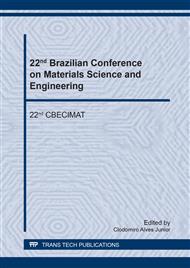p.32
p.37
p.43
p.48
p.53
p.57
p.63
p.67
p.73
Comparative Analysis of the Influence of 10 and 5% Hydrofluoric Acid Etching on the Average Roughness of Lithium Disilicate Used in Dental Prostheses
Abstract:
The objective of this study was to analyse the variation of the average roughness (Ra) of a dental ceramic based on lithium disilicate after the etching of the surface with hydrofluoric acid (HF) in different concentrations in relation to the bond strength of this ceramic to the resin cement. The vitroceramic samples were divided into three groups: G1 (control, without etching), G2 (etching with HF 5%) and G3 (etching with HF 10%). The samples were exposed to the HF for 20 seconds at both concentrations. The average surface roughness after etching was analysed using the Confocal Zeiss Axio CSM 700 microscope and after the cementation and photoactivation of the resin cement the samples were submitted to a micro-shear test. The morphological analysis showed that the etching promoted the dissolution of the vitreous component and exposed the crystals of the ceramic for both concentrations, increasing the Ra values in relation to the control group (G1 = 0.331 ± 0.012 μm, G2 = 0.742 ± 0.126 μm; G3 = 1.335 ± 0.217 μm), with G3 having the highest Ra value. The highest values of bond strength were obtained by G3, with G1 = 17 ± 1.38 MPa, G2 = 24 ± 1.47 MPa and G3 = 30 ± 2.83 MPa. It can be concluded that the increase of the Ra by the HF etching promoted an increase of the bond strength between the lithium disilicate and the resin cement. However, the most effective superficial etching was with 10% HF.
Info:
Periodical:
Pages:
53-56
Citation:
Online since:
September 2018
Keywords:
Price:
Сopyright:
© 2018 Trans Tech Publications Ltd. All Rights Reserved
Share:
Citation:


